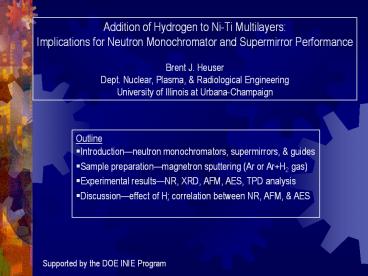Addition of Hydrogen to Ni-Ti Multilayers: - PowerPoint PPT Presentation
Title:
Addition of Hydrogen to Ni-Ti Multilayers:
Description:
Dept. Nuclear, Plasma, & Radiological Engineering. University of Illinois at Urbana ... Auger Electron Spectroscopy Measurements of Atomic Concentration ... – PowerPoint PPT presentation
Number of Views:101
Avg rating:3.0/5.0
Title: Addition of Hydrogen to Ni-Ti Multilayers:
1
Addition of Hydrogen to Ni-Ti Multilayers Implica
tions for Neutron Monochromator and Supermirror
Performance Brent J. Heuser Dept. Nuclear,
Plasma, Radiological Engineering University of
Illinois at Urbana-Champaign
- Outline
- Introductionneutron monochromators,
supermirrors, guides - Sample preparationmagnetron sputtering (Ar or
ArH2 gas) - Experimental resultsNR, XRD, AFM, AES, TPD
analysis - Discussioneffect of H correlation between NR,
AFM, AES
Supported by the DOE INIE Program
2
Acknowledgements Hyunsu Ju (NPRE UIUC) Sungkyun
Park (IPNS ANL) Rick Goyette (SNS ORNL) UIUC
FS-MRL staff Tony Banks Nancy Finnegan Scott
MacLaren Vania Petrova Mauro Sardela
3
Cold Neutron Guide Halls
Orphée Reactor Guide Hall at the LLB, Saclay
Neutron guides transport long wavelength neutrons
far from reactor containment where neutron and
gamma-ray backgrounds are much lower. Guides
are based on total external reflection and must
be very efficient.
NIST Reactor Guide Hall
4
Neutron Guides Evacuated channels with coatings
on top, bottom, and sides
that reflect neutrons.
Cold Source
LH2 or CH4 4-25 K
5
Review of Basic Neutron Optical Elements
Single-layer films
R
l fixed
q or Q
qc or Qc
6
(No Transcript)
7
Review of Basic Neutron Optical Elements
NiC-Ti
8
Fabrication of Ni-Ti Multilayer Films Using
Magnetron Sputtering
Samples 500 Å Ni 500 Å Ti 1 Ni-Ti BL 2 Ni-Ti
BL 4 Ni-Ti BL 6 Ni-Ti BL 10 Ni-Ti BL 15 Ni-Ti
BL 20 Ni-Ti BL 40 Ni-Ti BL
Growth rate 0.4 Å /sec Bi-layer spacing 80 Å
9
Neutron Reflectivity MeasurementsPOSY 2 _at_
IPNS-ANL
10
Fits to the Neutron Reflectivity Measurements
Fits not unique!
11
Atomic Force Microscopy Measurements of Surface
Roughness
Gradual increase in roughness of top surface is
observed that is consistent with degradation of
reflectivity for BL gt 6.
12
Auger Electron Spectroscopy Measurements of
Atomic Concentration
Oxygen content at noise level oscillations in
oxygen signal in 20 w/H ML sample have same
period as Ti and Ni oscillations, but correlated
to Ti. Concentration profiles for Ti in the
with-hydrogen ML samples are flat indicating
uniform hydrogen concentration within Ti
layers. Ti and Ni signal oscillations in ML
samples dampen away from the film-substrate
inter- face, consistent with increase surface
roughness for high BL number observed with AFM.
13
Correction to Theoretical 1st Order Peak
Reflectivity
14
Temperature Programmed Desorption Measurements of
Hydrogen Concentration
Sample H/Ti
500 A 2.0
40 ML w/H 2.0
20 ML w/H 2.2
10 ML w/H 1.5
6 ML w/H 2.5
4 ML w/H 1.7
2 ML w/H 1.7
40 ML w/o H 0.7
20 ML w/o H 0.8
10 ML w/o H 1.0
6 ML w/o H 0.8
4 ML w/o H 0.9
2 ML w/o H 1.2
40 ML w/o H 0.4
20 ML w/o H 0.3
15
Conclusion
Addition of hydrogen to Ti worksincrease in 1st
order diffraction peak reflectivity observed.
Gains in on-sample intensity of 2-3 should be
possible without too much effort. Degradation
in 1st order peak reflectivity with BL value
consistent with surface roughening observed with
AFM. Larger interfacial roughness as BL value
increases was observed with AES, consistent with
AFM.
16
Orphee ReactorLLB Saclay
NBS Reactor LH2 Cold Source NIST
17
Auger Electron Spectroscopy Measurements of
Atomic Concentration
40 ML w/H
Oxygen content at noise level oscillations in
oxygen signal in 20 w/H ML sample have same
period as Ti and Ni oscillations, but correlated
to Ti. Concentration profiles for Ti in the
with-hydrogen ML samples are flat indicating
uniform hydrogen concentration within Ti
layers. Ti and Ni signal oscillations in ML
samples dampen away from the film-substrate
inter- face, consistent with increase surface
roughness for high BL number observed with AFM.
Bulk Ni
20 ML w/H
Bulk Ti
10 ML w/H
20 ML w/o H
18
(No Transcript)
19
Addition of Hydrogen to Ni-Ti Multilayers Implica
tions for Neutron Supermirror Performance Brent
J. Heuser, UIUC Hyunsu Ju, UIUC Sungkyun Park
(ANL), Rick Goyette (ANL), Tony Banks (UIUC),
Nancy Finnegan (UIUC), Scott MacLaren (UIUC),
Vania Petrova (UIUC) Mauro Sardela (UIUC)
- Neutron opticsmonochromators and supermirrors
- Sample preparation.
- Experimental resultsNR, XRD, AFM, AES, TPD
analysis
Supported by the DOE INIE Program































